You’ll need to master jewelry files and burrs to achieve professional-quality precision in your metalwork. Files remove material and refine surfaces, while burrs create textures and grooves using power tools. Choose from flat, half-round, and round files in various grades from coarse to fine. Stone setting, cone, ball, and cylinder burrs handle specific tasks like prong adjustment and creating recesses. Material options include high-speed steel, carbide, and diamond-coated varieties for different durability needs. Proper maintenance and speed settings will elevate your craftsmanship considerably.
Understanding the Fundamentals of Jewelry Files and Burrs
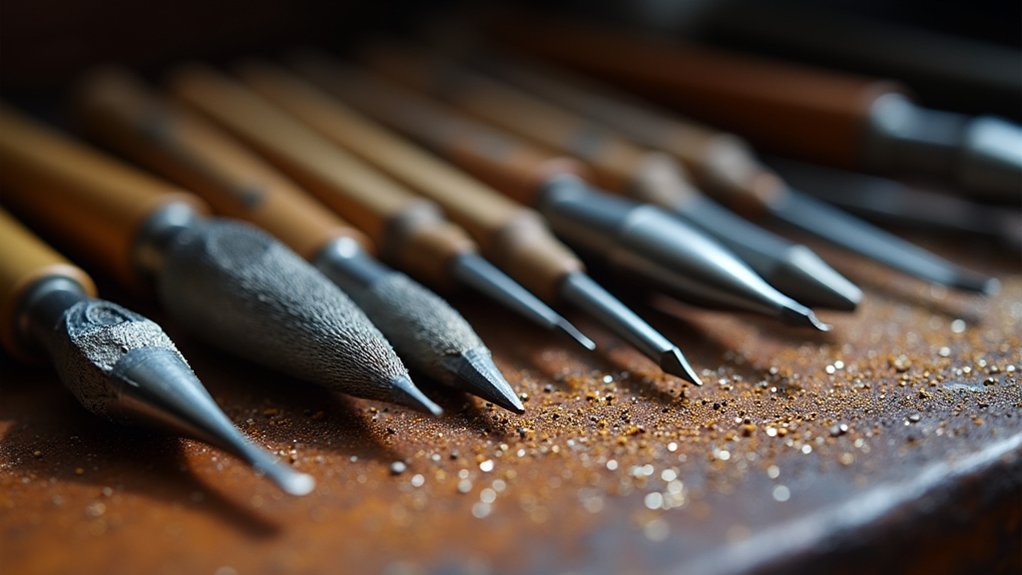
Precision defines the difference between amateur and professional jewelry work, and mastering files and burrs forms the foundation of exceptional craftsmanship.
These essential tools serve distinct purposes in jewelry-making: files excel at removing material and refining surfaces, while burrs create specific textures, grooves, and setting adjustments.
You’ll encounter files in three primary shapes—flat, half-round, and round—each designed for different shaping requirements. Their grades range from coarse for heavy material removal to fine for delicate finishing work.
Burrs, including stone setting and cone varieties, pair with power tools like Dremel grinders for precision tasks.
Understanding which tool suits each application guarantees efficient workflow and superior results.
Whether you’re smoothing rough edges or creating intricate details, selecting appropriate files and burrs transforms raw metal into polished jewelry components.
Essential Materials Used in Jewelry File and Burr Construction
When you’re selecting jewelry files and burrs, you’ll find they’re constructed from several key materials that directly impact their performance and longevity.
Steel varieties like high-speed steel and vanadium offer different balances of cost and durability, while carbide construction provides exceptional hardness for demanding applications.
For specialized work with hard materials, diamond-coated options deliver superior cutting efficiency that standard steel can’t match.
Steel Types and Properties
Three primary steel types form the backbone of jewelry file and burr construction, each offering distinct advantages that’ll influence your tool selection and project outcomes.
| Steel Type | Cost | Durability | Best For |
|---|---|---|---|
| Vanadium | Lowest | Quick wear | Low-speed precision work |
| High-Speed Steel (HSS) | Moderate | Good balance | Professional applications |
| Carbide | Highest | Longest lasting | Heavy-duty tasks |
When selecting steel types for jewelry making, you’ll find vanadium offers precision cutting at budget-friendly prices but wears quickly. HSS provides excellent cost-to-durability ratios while maintaining hardness during high-speed operations. Carbide delivers superior properties with hardness approximately ten times greater than HSS, maintaining sharp edges under demanding conditions. Each type’s unique characteristics make them suitable for specific materials and applications in your jewelry workshop.
Carbide Construction Benefits
Although tungsten carbide costs more initially, you’ll discover its exceptional hardness delivers unmatched performance that transforms your jewelry-making experience.
These carbide burrs maintain razor-sharp edges while operating at high speeds, outlasting high-speed steel tools by up to ten times. You’ll achieve precise material removal across precious metals and other materials without frequent tool replacement.
The powder metallurgy manufacturing process combines tungsten carbide with metallic binders, creating tools with superior strength and wear resistance.
You’ll find various shapes and cuts designed for specific tasks like shaping, grinding, and deburring. This versatility guarantees you can tackle intricate designs with confidence.
Your investment in carbide construction pays dividends through consistent, high-quality results and reduced downtime in jewelry making projects.
Diamond Point Applications
Diamond points represent the pinnacle of precision tooling in jewelry making, featuring high-quality diamond particles embedded in a metal matrix that delivers unparalleled hardness and cutting performance.
You’ll find these tools excel when working with hard materials like metals, ceramics, and glass, enabling intricate detailing and fine finishes essential for professional-quality jewelry design.
The diamond coating considerably reduces wear compared to traditional steel burrs, making them incredibly cost-effective for long-term use.
You can utilize diamond points for engraving, carving, and polishing applications, giving you exceptional versatility in your workshop.
Their ability to handle higher RPM speeds means you’ll complete precision cutting tasks faster while maintaining superior quality results throughout your jewelry-making process.
Stone Setting Burrs for Precision Metalwork
You’ll find stone setting burrs in essential shapes like cone and ball varieties, each designed for specific precision tasks in metalwork.
These specialized tools let you adjust setting depths, refine prongs, and cut precise seats in bezels with remarkable accuracy.
When you’re working on intricate stone settings, you’ll need to master proper usage techniques with both high-speed rotary tools and pin vices for ideal results.
Essential Burr Shape Types
When precision metalwork demands exacting results, stone setting burrs become your primary tools for creating professional-quality jewelry pieces.
Three essential burr shapes dominate the stone setting workflow, each serving distinct cutting functions on metals.
Cone burrs excel at sculpting sharp, defined claws that securely grip gemstones. Their tapered design allows precise material removal while maintaining structural integrity.
Ball burrs create perfectly rounded recesses for cabochons and spherical stones, ensuring uniform contact surfaces. These spherical cutters eliminate sharp edges that could damage delicate gems.
Cylinder burrs reach confined spaces where other shapes can’t access. They’re indispensable for adding texture to metal surfaces and refining tight corners in complex settings.
Their straight walls provide consistent cutting depth, making them ideal for creating uniform channels and cleaning up detailed areas in intricate jewelry designs.
Proper Usage Techniques
Although stone setting burrs offer exceptional precision, mastering their proper usage techniques determines whether you’ll achieve professional results or damage both your tools and workpiece.
You’ll need the correct speed and moderate pressure for peak cutting efficiency. Stone setting burrs work best with pendant motors like Dremel Multi Tools, enabling quick accessory changes during detailed work.
| Technique | Best Practice | Result |
|---|---|---|
| Speed Control | Use moderate RPM | Prevents overheating |
| Pressure Application | Apply gentle, consistent force | Extends burr life |
| Tool Changes | Utilize pendant motor system | Improves workflow |
Regular maintenance keeps your burrs sharp and efficient. Lubricate moving parts, check for wear, and store them properly in racks away from other tools. This prevents damage and maintains cutting performance for precision metalwork tasks.
Cone Burrs for Sculpting and Claw Adjustment
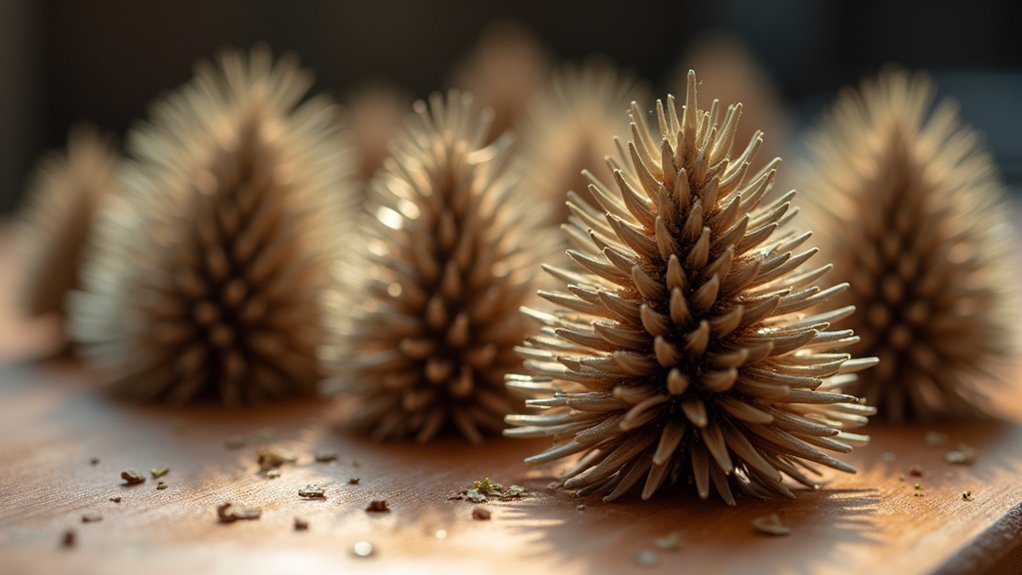
Precision becomes paramount when you’re adjusting delicate claw settings or sculpting intricate jewelry details, and cone burrs deliver exactly that level of control.
These specialized tools feature a straight taper that’s perfect for fine-tuning prongs and ensuring secure stone placement in your jewelry pieces.
The straight taper design makes cone burrs ideal for precision prong work and achieving secure stone settings.
You’ll find cone burrs excel at accessing tight spaces where other tools can’t reach. Their tapered design lets you create smooth edges and contours on both metal and stone settings.
When you need to enlarge holes or adjust cavities for different stone sizes, cone burrs provide the accuracy you need.
Available in various sizes and grits, they offer versatility for achieving different textures and finishes.
Paired with your high-speed rotary tool, cone burrs dramatically reduce time spent on claw adjustment and sculpting tasks.
Ball and Round Burrs for Creating Recesses and Grooves
Sculptural mastery in jewelry making demands tools that can carve perfect concave cuts, and ball and round burrs deliver exactly that capability.
You’ll find these rounded burrs essential for intricate detailing when crafting secure gemstone settings and decorative grooves. Their spherical design lets you create recesses with smooth, professional finishes that cradle stones perfectly.
You can choose from multiple sizes to achieve precise depths and contours, giving your designs unlimited customization potential.
These versatile tools work effectively on gold, silver, platinum, plastics, and wood, expanding your creative possibilities.
When you pair ball and round burrs with high-speed rotary tools, you’ll achieve superior efficiency and finish quality that both hobbyist and professional jewelers depend on for exceptional results.
Cylinder Burrs for Hard-to-Reach Areas and Texturing
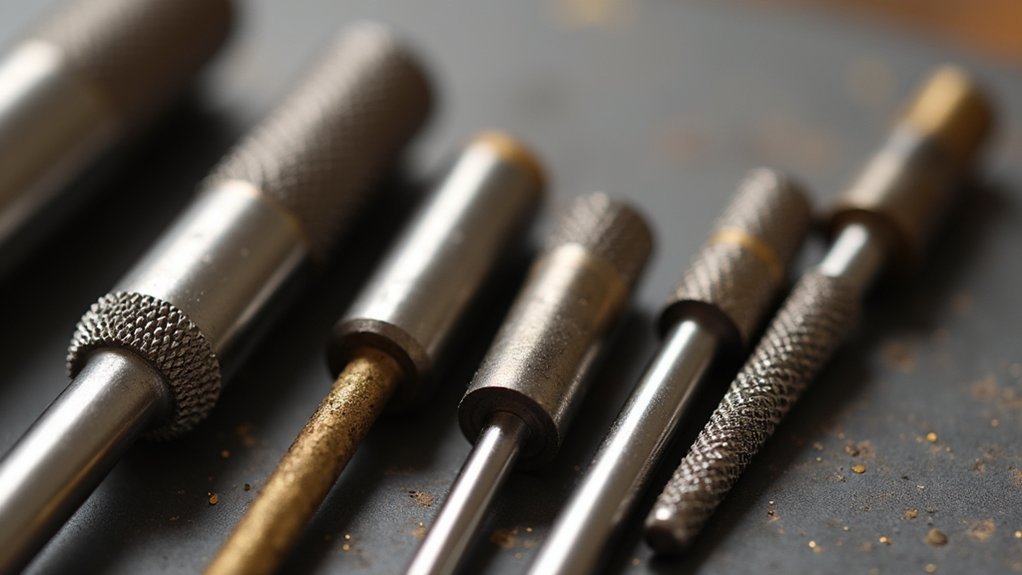
You’ll find cylinder burrs indispensable when you need to access cramped spaces between prongs or inside narrow bezels where other tools simply can’t reach.
Their straight-sided design gives you precise cutting control, making them perfect for creating consistent surface textures and patterns on your jewelry pieces.
The cylindrical shape’s uniform cutting action allows you to work efficiently in tight quarters while maintaining the exact texture depth you’re aiming for.
Accessing Tight Spaces
When intricate jewelry designs feature narrow channels, tight corners, or confined spaces between prongs, cylinder burrs become your go-to solution for accessing areas where traditional files can’t reach.
Their straight-sided cylindrical design allows you to maneuver into cramped quarters that would otherwise remain untouched.
You’ll find these specialized burrs excel at accessing tight spaces while maintaining control over your work. They can remove material efficiently from confined areas, whether you’re cleaning up casting imperfections or creating deliberate design elements.
The precision these tools offer makes precise texturing possible even in the most challenging locations.
Available in multiple sizes, you can select the perfect cylinder burr diameter for your specific application, ensuring ideal results in every tight space you encounter.
Creating Surface Textures
Texture creation transforms smooth metal surfaces into enchanting visual elements that catch light and add dimension to your jewelry pieces.
Cylinder burrs excel at creating grooves and intricate surface textures on precious metals like gold and silver. Their straight sides efficiently remove material while producing uniform patterns that enhance your jewelry’s aesthetic appeal.
When you’re working with cylinder burrs, you’ll discover their exceptional versatility:
- Precise control for detailed texturing in hard-to-reach areas
- Consistent finishes across various material known for durability
- Enhanced efficiency when paired with pendant motors or rotary tools
- Professional results suitable for both hobbyists and experienced jewelers
- Extended lifespan through proper maintenance and storage practices
These specialized tools transform ordinary metal surfaces into mesmerizing focal points that elevate your jewelry designs.
Straight-Sided Cutting Action
Because cylinder burrs feature perfectly straight sides, they deliver unmatched precision when accessing tight corners and confined spaces in your jewelry work. These specialized tools excel at cutting and shaping flat surfaces where other burrs can’t reach effectively.
You’ll find cylinder burrs particularly valuable for precision texturing, creating defined patterns that enhance your pieces’ aesthetic appeal. Their versatility extends beyond metals to softer materials like plastics and wood, expanding your creative possibilities.
| Application | Benefit | Material |
|---|---|---|
| Prong refinement | Clean, precise cuts | Precious metals |
| Hole enlargement | Controlled expansion | Various alloys |
| Detail work | Intricate designs | Mixed media |
For ideal results in jewelry making, maintain consistent speed and apply moderate pressure. This approach guarantees smooth finishes while extending your burr’s lifespan, making them indispensable for professional-quality work.
Cup Burrs for Wire End Finishing and Prong Work
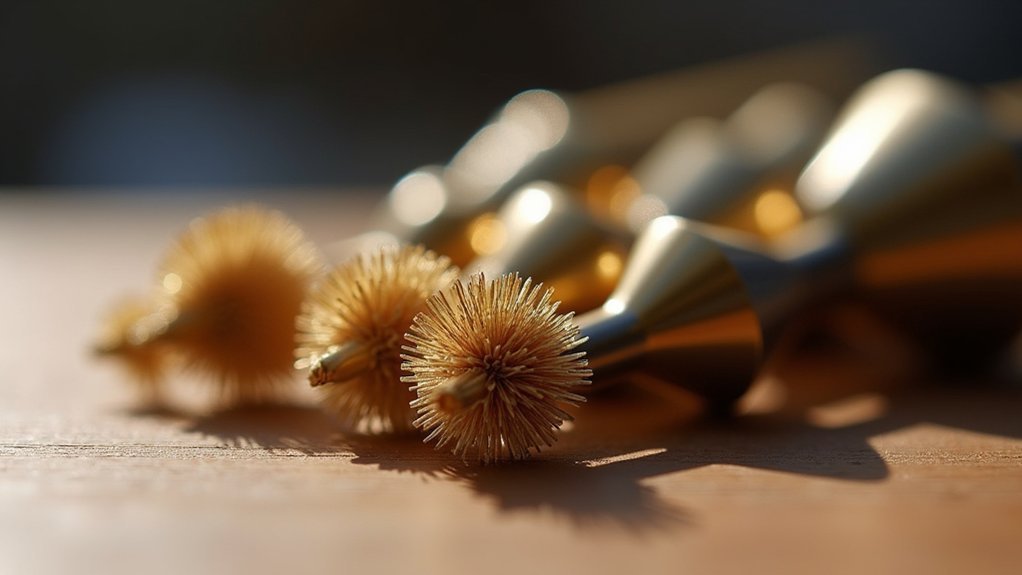
Precision in wire work separates amateur jewelry making from professional-grade craftsmanship, and cup burrs deliver exactly that level of refinement for your wire end finishing and prong work.
Cup burrs transform rough wire ends into polished, professional finishes that distinguish quality jewelry making from amateur attempts.
These specialized tools feature flutes inside a cup-shaped head, making them incredibly effective for smoothing and rounding wire ends in jewelry making applications.
Cup burrs excel at creating professional results through their unique design:
- Prong refinement – Perfect prong tips for secure stone settings in rings
- Domed rivet heads – Create aesthetically appealing finished jewelry pieces
- Multiple sizes – Accommodate various wire gauges for versatility
- Smooth finishing – Eliminate sharp edges that could irritate wearers
- Quick operation – Efficiently round wire ends with minimal effort
Regular use greatly improves your jewelry quality by providing consistent, polished finishes essential for professional-grade work.
Carbide Burr Shapes and Their Specialized Applications
While cup burrs excel at wire finishing, carbide burr shapes expand your capabilities dramatically through their diverse shapes, each engineered for specific applications that’ll transform how you approach metalworking projects.
Burrs are versatile tools that maximize cutting efficiency based on your project’s demands.
Cylindrical shapes handle flat surface grinding, while spherical burrs create smooth concave cuts. You’ll find tapered burrs perfect for accessing tight spaces during intricate work. Inverted cone shapes excel at creating undercuts for dovetail joints, and flame shapes polish rounded edges beautifully.
For specialized applications requiring precision detailing, pointed burrs deliver exceptional control during fine carving work. Double-cut varieties generate smaller chips when removing material quickly, ensuring smoother finishes across metals and non-metallic materials in your jewelry-making projects.
Selecting the Right Tools for Burr Operation
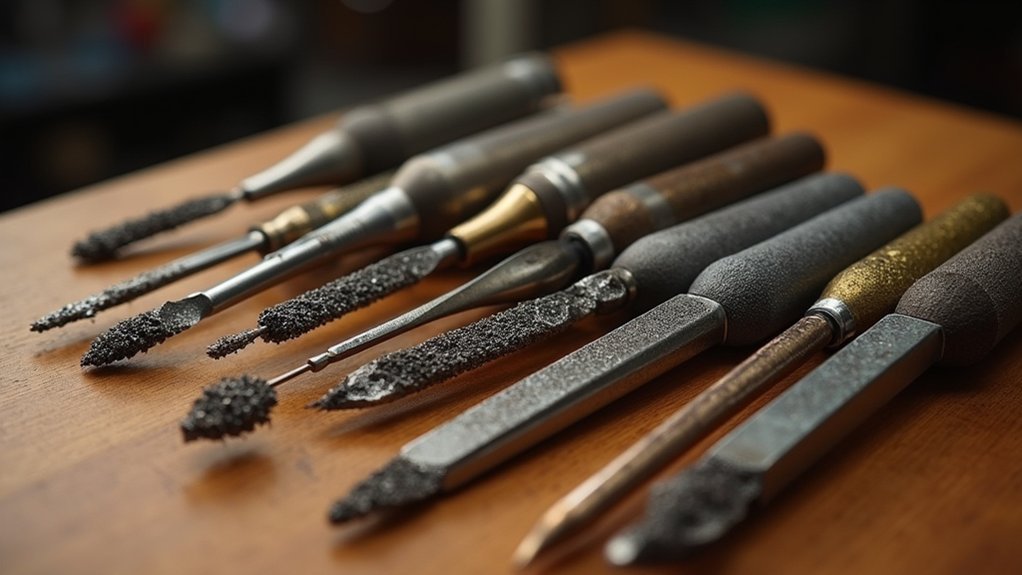
Three critical factors determine your burr operation success: tool selection, compatibility, and control precision.
Selecting the right tools for your jewelry work requires careful consideration of both power sources and burr materials.
Careful tool selection balances power source capabilities with burr material properties to optimize jewelry crafting precision and efficiency.
High-speed rotary tools like Dremel Multi Tools deliver efficient performance for most operations. However, when you need detailed adjustments, a pin vice provides superior control for precision handwork.
- Choose carbide burrs for superior cutting edges and longevity when working with harder metals
- Match burr shapes (cone, ball, cylinder) to your specific task requirements
- Use high-speed rotary tools for efficient, smooth performance
- Switch to pin vices for detailed precision work
- Regularly inspect and maintain burrs with proper lubrication and upright storage
Material selection greatly impacts performance—carbide burrs offer exceptional durability and maintain sharp cutting edges longer than standard options.
Proper Storage and Maintenance Techniques
You’ll extend your jewelry files and burrs’ lifespan markedly by implementing proper storage and maintenance techniques.
Start with upright storage solutions that protect cutting edges, then establish regular lubrication and cleaning routines to keep tools performing at their best.
These damage prevention methods aren’t just recommendations—they’re essential practices that’ll save you money and guarantee consistent results in your jewelry work.
Upright Storage Solutions
When you store your jewelry files and burrs upright, you’re protecting these precision tools from the damage that occurs when they touch each other or rest flat in drawers. This storage method maintains their cutting edges and extends their operational lifespan considerably.
Effective upright storage requires specific solutions that enhance both organization and maintenance:
- Dedicated tool racks with individual slots prevent burrs from contacting each other
- Foam blocks with custom holes provide secure, accessible positioning for different sizes
- Magnetic strips offer convenient wall-mounted storage for steel tools
- Rotating carousels maximize workspace efficiency while keeping tools visible
- Compartmentalized containers with vertical dividers separate tools by type and size
These storage solutions create an organized workspace where you can quickly locate the right tool while ensuring your burrs remain sharp and damage-free for consistent performance.
Lubrication and Cleaning
Beyond organizing your tools properly, maintaining clean and well-lubricated burrs directly impacts their cutting performance and longevity.
You’ll need to clean your burrs regularly to remove metal debris and prevent clogging, which causes overheating and poor cutting results. Use a brass brush or ultrasonic cleaner to eliminate stubborn particles from the cutting surfaces.
Proper lubrication keeps your burrs sharp and reduces friction during operation.
Apply a light coating of cutting oil or specialized burr lubricant before each use. This prevents premature wear and guarantees smooth cutting action.
Don’t forget to inspect each burr before starting work.
Look for chips, excessive wear, or damaged cutting edges. Replace worn burrs immediately to maintain peak performance and prevent damage to your jewelry pieces.
Damage Prevention Methods
While proper cleaning and lubrication form the foundation of burr care, implementing strategic damage prevention methods will greatly extend your tools’ working life.
Smart storage practices protect your investment and maintain cutting precision. You’ll want to establish protective habits that prevent costly replacements and frustrating performance issues.
- Store burrs and files upright in dedicated racks to prevent contact damage and dulling
- Use specific containers designed for burr storage to enhance accessibility while minimizing risks
- Regularly inspect your tools for wear patterns and replace worn burrs before they compromise your work
- Keep cutting surfaces separated using individual slots or protective sleeves
- Maintain consistent maintenance schedules to catch potential problems early
These damage prevention strategies guarantee your burrs deliver consistent, professional results throughout their extended lifespan.
Speed Settings and Safety Considerations
Operating rotary tools with jewelry files and burrs requires precise speed control to achieve professional results while maintaining safety.
You’ll want to operate between 12,000 to 30,000 RPM for ideal cutting efficiency. Match your speed settings to the material—softer plastics need lower speeds, while harder metals can handle higher RPMs.
Always secure your workpiece firmly before starting to prevent dangerous movement and uneven finishes.
Properly securing your workpiece is essential for preventing hazardous movement and ensuring smooth, professional finishes during rotary tool operations.
Don’t skip personal protective equipment; wear safety goggles and masks to shield yourself from flying debris and dust particles.
Regular maintenance greatly impacts tool life. Clean your burrs and files after each use to remove accumulated debris, and inspect them for wear regularly.
This routine keeps you safe and extends your tools’ lifespan considerably.
File Types and Their Specific Jewelry Applications
Understanding the proper tools for each jewelry-making task will maximize your investment in quality files and burrs. Different file shapes serve specific purposes in your workshop, from basic shaping to intricate finishing work.
- Flat files excel at shaping large surfaces and creating straight edges on metal pieces.
- Half-round files provide versatility for both flat surfaces and curved areas during forming.
- Needle files offer precision for detailing work in tight spaces on delicate components.
- Swiss pattern files deliver superior smoothness for fine finishing and polishing tasks.
- Stone setting burrs allow precise adjustment of setting depths while sculpting metal textures.
You’ll find needle files particularly valuable for intricate detailing work, while cup burrs efficiently smooth wire ends and refine prong tips.
Each tool’s unique design addresses specific challenges in professional jewelry making.
Troubleshooting Common Issues and Wear Patterns
Even with proper technique, your files and burrs will eventually show signs of wear that can compromise your jewelry work’s quality.
Clogging presents the most frequent problem, particularly when working with softer materials like plastics. You’ll notice reduced cutting efficiency and debris buildup. Combat this by using appropriate cutting speeds and lubricants during operation.
Watch for wear patterns like dullness or uneven cutting edges on your burrs, which signal it’s time for sharpening or replacement.
Files develop rounded teeth and lose their cutting ability over time. Chipping or breakage often results from excessive pressure or incorrect speed settings.
Prevent these issues through regular maintenance. Clean your tools after each use to remove debris buildup and extend tool life, ensuring consistently professional results.
Professional Tips for Maximizing Tool Performance
Beyond addressing wear and maintenance problems, maximizing your file and burr performance requires strategic technique and setup choices.
Smart jewelers know that proper tool management directly impacts their finished work quality.
Here’s how you’ll achieve professional-level results:
- Select the appropriate type of burr or file for each specific task, matching the shape and cut to your desired finish.
- Apply consistent pressure during use to prevent overheating and extend tool lifespan while avoiding damage.
- Maintain burrs by cleaning them regularly to prevent material buildup that impedes performance.
- Store burrs upright in designated racks to prevent tool contact damage and preserve sharpness.
- Utilize variable speed motors for enhanced precision control and minimized risk.
These techniques guarantee your tools deliver consistent, professional results while maximizing their operational lifespan.
Frequently Asked Questions
Can Jewelry Files and Burrs Be Used on Precious Stones and Gems?
You shouldn’t use jewelry files and burrs directly on precious stones and gems because they’re too abrasive and will scratch or damage them. Instead, you’ll need specialized diamond-tipped tools for gemstone work.
How Do I Sharpen Dull Jewelry Files and Burrs at Home?
You can’t effectively sharpen jewelry files at home since they’re precision tools. For burrs, use a brass brush or steel wool to clean debris, but replacement is usually more cost-effective than attempting sharpening.
What’s the Difference Between Rotary Tool Burrs and Hand-Held Jewelry Files?
You’ll use rotary tool burrs with electric tools for faster material removal and detailed work, while hand-held jewelry files require manual effort but give you more precise control over pressure and cutting action.
Are There Eco-Friendly or Sustainable Options for Jewelry Files and Burrs?
You’ll find sustainable options like recycled steel files, wooden handles from responsibly sourced timber, and diamond-coated burrs that last longer, reducing waste. Some manufacturers now offer refurbishment services for worn tools.
Can I Use Dental Burrs as Substitutes for Jewelry-Specific Burrs?
You can use dental burrs for jewelry work, but they’re typically made for softer materials. They’ll work on precious metals but may wear faster than jewelry-specific burrs designed for harder materials.
In Summary
You’ve now got the essential knowledge to master jewelry files and burrs in your metalworking projects. Remember to match your tool selection to specific tasks, maintain proper speed settings, and prioritize safety throughout your work. Regular maintenance and understanding wear patterns will extend your tools’ lifespan considerably. With practice, you’ll develop the precision and confidence needed to create professional-quality jewelry pieces that showcase your craftsmanship and attention to detail.





Leave a Reply